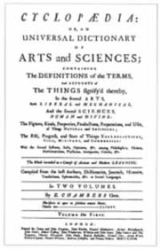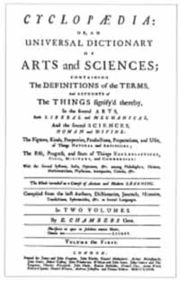
Cyclopaedia, or Universal Dictionary of Arts and Sciences
Encyclopedia


Book size
The size of a book is generally measured by the height against the width of a leaf, or sometimes the height and width of its cover. A series of terms is commonly used by libraries and publishers for the general sizes of modern books, ranging from "folio" , to "quarto" and "octavo"...
) was an encyclopedia
Encyclopedia
An encyclopedia is a type of reference work, a compendium holding a summary of information from either all branches of knowledge or a particular branch of knowledge....
published by Ephraim Chambers
Ephraim Chambers
Ephraim Chambers was an English writer and encyclopaedist, who is primarily known for producing the Cyclopaedia, or a Universal Dictionary of Arts and Sciences.-Early life:...
in London
London
London is the capital city of :England and the :United Kingdom, the largest metropolitan area in the United Kingdom, and the largest urban zone in the European Union by most measures. Located on the River Thames, London has been a major settlement for two millennia, its history going back to its...
in 1728, and reprinted in numerous editions in the eighteenth century. The Cyclopaedia was one of the first general encyclopedias to be produced in English.
The 1728 subtitle gives a summary of the aims of the author:
- Cyclopaedia, or, An Universal Dictionary of Arts and Sciences: Containing the Definitions of the Terms, and Accounts of the Things Signify'd Thereby, in the Several Arts, both Liberal and Mechanical, and the Several Sciences, Human and Divine: the Figures, Kinds, Properties, Productions, Preparations, and Uses, of Things Natural and Artificial; the Rise, Progress, and State of Things Ecclesiastical, Civil, Military, and Commercial: with the Several Systems, Sects, Opinions, etc; among Philosophers, Divines, Mathematicians, Physicians, Antiquaries, Criticks, etc.: The Whole Intended as a Course of Ancient and Modern Learning.
Noteworthy features
The first edition included numerous cross-references meant to connect articles scattered by the use of alphabetical order, a dedication to the King, George IIGeorge II of Great Britain
George II was King of Great Britain and Ireland, Duke of Brunswick-Lüneburg and Archtreasurer and Prince-elector of the Holy Roman Empire from 11 June 1727 until his death.George was the last British monarch born outside Great Britain. He was born and brought up in Northern Germany...
, and a philosophical preface at the beginning of Volume 1. Among other things, the preface gives an analysis of forty-seven divisions of knowledge, with classed lists of the articles belonging to each, intended to serve as a table of contents and also as a directory indicating the order in which the articles should be read.
Printing history
A second edition appeared in 1738 in two volumes in folio, with 2,466 pages. This edition was supposedly retouched and amended in a thousand places, with a few added articles and some enlarged articles. Chambers was prevented from doing more because the booksellers were alarmed by a bill in ParliamentParliament of the United Kingdom
The Parliament of the United Kingdom of Great Britain and Northern Ireland is the supreme legislative body in the United Kingdom, British Crown dependencies and British overseas territories, located in London...
containing a clause to oblige the publishers of all improved editions of books to print their improvements separately. The bill, after passing the House of Commons
British House of Commons
The House of Commons is the lower house of the Parliament of the United Kingdom, which also comprises the Sovereign and the House of Lords . Both Commons and Lords meet in the Palace of Westminster. The Commons is a democratically elected body, consisting of 650 members , who are known as Members...
, was unexpectedly thrown out by the House of Lords
House of Lords
The House of Lords is the upper house of the Parliament of the United Kingdom. Like the House of Commons, it meets in the Palace of Westminster....
; but fearing that it might be revived, the booksellers thought it best to retreat though more than twenty sheets had been printed.
Five other editions were published in London from 1739 to 1751–1752. An edition was also published in Dublin in 1742; this and the London editions were all 2 volumes in folio. An Italian translation appearing in Venice
Venice
Venice is a city in northern Italy which is renowned for the beauty of its setting, its architecture and its artworks. It is the capital of the Veneto region...
, 1748-1749, 4to, 9 vols., was the first complete Italian encyclopaedia. When Chambers was in France in 1739 he rejected very favorable proposals to publish an edition there dedicated to Louis XV.
Chambers' work was carefully done, and popular. It had, however, defects and omissions, as he was well aware; and at his death, on 15 May 1740, he had collected and arranged materials for seven new volumes. George Lewis Scott
George Lewis Scott
-Life:Born at Hanover in May 1708, he was the eldest son of George Scott of Bristo in Scotland, and Marion Stewart, daughter of Sir James Stewart of Coltness, Lord Advocate of Scotland. George Scott held diplomatic posts at various German courts, and was envoy-extraordinary to Augustus II the...
was employed by the booksellers to select articles for the press and to supply others, but he left before the job was finished. The job was then given to Dr. John Hill
John Hill (author)
John Hill , called because of his Swedish honours, "Sir" John Hill, was an English author and botanist. He contributed to contemporary periodicals and was awarded the title of Sir in recognition of his illustrated botanical compendium The Vegetable System.He was the son of the Rev. Theophilus Hill...
. The Supplement was published in London in 1753 in two folio volumes with 3307 pages and 12 plates. Hill was a botanist, and the botanical part, which had been weak in the Cyclopaedia, was the best.
Abraham Rees
Abraham Rees
Abraham Rees was a Welsh nonconformist minister, and compiler of Rees's Cyclopaedia .- Life :He was the second son of Lewis Rees, by his wife Esther, daughter of Abraham Penry, and was born at born in Llanbrynmair, Montgomeryshire. Lewis Rees Abraham Rees (1743 – 9 June 1825) was a Welsh...
, a Nonconformist minister, published a revised and enlarged edition in 1778–1788, with the supplement and improvements incorporated. It was published in London, as a folio of 5 vols., 5010 pages (but not paginated), and 159 plates. It was published in 418 numbers at 6d. each. Rees claimed to have added more than 4400 new articles. At the end he gave an index of articles, classed under 100 heads, numbering about 57,000 and filling 80 pages. The heads, with 39 cross references, were arranged alphabetically.
Precursors and the Encyclopédie
Among the precursors of Chambers's Cyclopaedia was John HarrisJohn Harris (writer)
John Harris was an English writer, scientist, and Anglican priest. He is best known as the editor of the Lexicon Technicum: Or, A Universal English Dictionary of Arts and Sciences , the earliest of English encyclopaedias, and as the compiler of the Collection of Voyages and Travels which was...
's Lexicon Technicum
Lexicon technicum
Lexicon Technicum: Or, An Universal English Dictionary of Arts and Sciences: Explaining not only the Terms of Art, but the Arts Themselves was in many respects the first alphabetical encyclopedia written in English...
, of 1704 (later editions from 1708 through 1744). By its title and content it was "An Universal English Dictionary of Arts and Sciences: Explaining not only the Terms of Art, but the Arts Themselves." While Harris's work is often classified as a technical dictionary, it also took material from Newton
Isaac Newton
Sir Isaac Newton PRS was an English physicist, mathematician, astronomer, natural philosopher, alchemist, and theologian, who has been "considered by many to be the greatest and most influential scientist who ever lived."...
and Halley
Edmond Halley
Edmond Halley FRS was an English astronomer, geophysicist, mathematician, meteorologist, and physicist who is best known for computing the orbit of the eponymous Halley's Comet. He was the second Astronomer Royal in Britain, following in the footsteps of John Flamsteed.-Biography and career:Halley...
among others.
Chambers's Cyclopaedia in turn became the inspiration for the landmark Encyclopédie
Encyclopédie
Encyclopédie, ou dictionnaire raisonné des sciences, des arts et des métiers was a general encyclopedia published in France between 1751 and 1772, with later supplements, revised editions, and translations. It was edited by Denis Diderot and Jean le Rond d'Alembert...
of Denis Diderot
Denis Diderot
Denis Diderot was a French philosopher, art critic, and writer. He was a prominent person during the Enlightenment and is best known for serving as co-founder and chief editor of and contributor to the Encyclopédie....
and Jean le Rond d'Alembert
Jean le Rond d'Alembert
Jean-Baptiste le Rond d'Alembert was a French mathematician, mechanician, physicist, philosopher, and music theorist. He was also co-editor with Denis Diderot of the Encyclopédie...
, which owed its inception to a proposed French
France
The French Republic , The French Republic , The French Republic , (commonly known as France , is a unitary semi-presidential republic in Western Europe with several overseas territories and islands located on other continents and in the Indian, Pacific, and Atlantic oceans. Metropolitan France...
translation of Chambers' work begun in 1743 by John Mills
John Mills (encyclopedist)
John Mills was an encyclopedist on the Encyclopédie. He was originally a writer on agricultural matters from England...
, assisted by Gottfried Sellius.
Further reading
- Bradshaw, Lael Ely. "Ephraim Chambers’ Cyclopedia." Notable Encyclopedias of the Seventeenth and Eighteenth Centuries: Nine Predecessors of the Encyclopédie. Ed. Frank Kafker. Oxford: The Voltaire Foundation, 1981. 123-137. (ISBN 0-7294-0256-8).
- Collison, Robert. Encyclopædias: Their History Throughout the Ages. New York: Hafner, 1966.
- Kafker, Frank. A. Notable encyclopedias of the late eighteenth century: eleven successors of the Encyclopédie. Oxford : Voltaire Foundation at the Taylor Institution, 1994.
- Kolb, Gwin J. and James H. Sledd. “Johnson’s ‘Dictionary’ and Lexicographical Tradition.” Modern Philology 50.3 (Feb. 1953): 171-194.
- Mack, Ruth. “The Historicity of Johnson’s Lexicographer.” Representations 76 (Fall 2001): 61-87.
- Shorr, Phillip. Science and Superstition in the Eighteenth Century: A Study of the Treatment of Science in Two Encyclopedias of 1725-1750. New York: Columbia, 1932.
- Walsh, S. Patraig. "Cyclopaedia." Anglo-American General Encyclopedias: A Historical Bibliography, 1703-1967. New York: R.R. Bowker, 1968. 38-39.
- Yeo, Richard. "The Best Book in the Universe": Ephraim Chambers’ Cyclopedia. In Encyclopædic Visions: Scientific Dictionaries and Enlightenment Culture. Cambridge: Cambridge UP, 2001. 120-169. (ISBN 0-521-65191-3)
- Yeo, Richard. Encyclopædic Visions: Scientific Dictionaries and Enlightenment Culture. Oxford: Cambridge University Press, 2001.
- Yeo, Richard R. "A Solution to the Multitude of Books: Ephraim Chambers's Cyclopaedia (1728) as "the Best Book in the Universe."" Journal of the History of Ideas, v. 64 (1), 2003. pp. 61-72. (ISSN 0022-5037)
External links
- Chambers' Cyclopaedia, 1728, 2 volumes, with the 1753 supplement, 2 volumes; digitized by the University of Wisconsin Digital Collections Center.
- Search the Cyclopaedia
- Index of entries (OCROptical character recognitionOptical character recognition, usually abbreviated to OCR, is the mechanical or electronic translation of scanned images of handwritten, typewritten or printed text into machine-encoded text. It is widely used to convert books and documents into electronic files, to computerize a record-keeping...
, contains many spelling errors)

